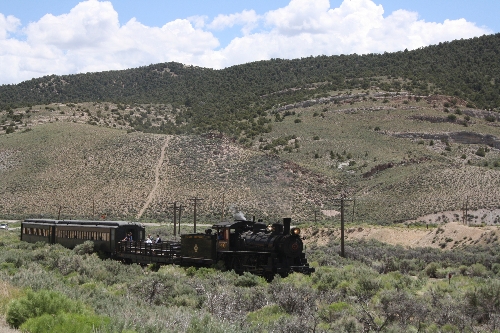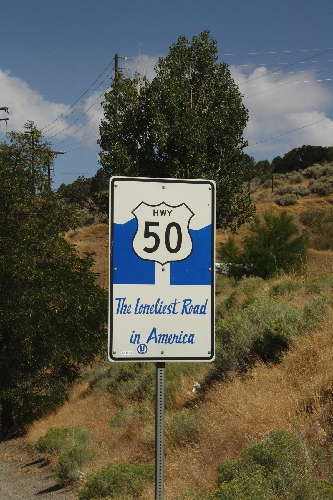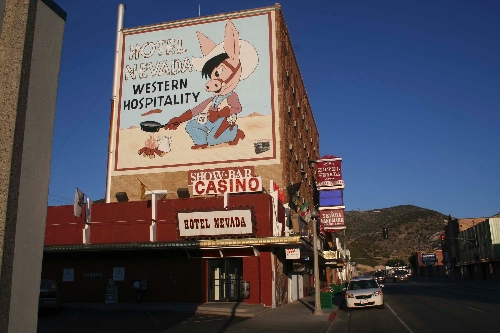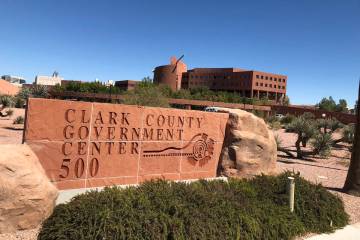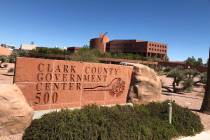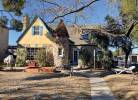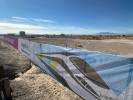Cerca: History near-constant companion on U.S. Highway 50
The Nevada segment of U.S. Highway 50 has been widely publicized as the "Loneliest Road in America." That almost makes it sound like a bad thing; in fact, it serves as a welcome escape for Southern Nevada urbanites hungry for a taste of the authentic rural West, unspoiled scenery and Nevada's rich history.
One of the best times to drive this road, which runs east-west across the center of the state, is June and July. The weather has warmed in the higher elevations, and the spring rains have made it as green as it will get this year, meaning you might see wildflowers at their best.
While you could drive the entire road in less than a day, I would recommend several days. If you can spare three of them, you will get the most out of your trip. For those travelers with children, be sure to pick up a Highway 50 Survival Guide booklet. They are available in Ely, Eureka, Austin, Fallon and Fernley visitor centers, besides various businesses, museums and chambers of commerce. When you stop at a new destination, get your book validated with a stamp. Once your book is filled, send it in to the Nevada Commission on Tourism and they will send you a Highway 50 survivor certificate and a pin to be worn proudly on a child's shirt or cowboy hat.
While it's up to you which direction to start, my preference is going east to west. That allows you to start each traveling day with the sun at your back and lighting up the landscape ahead as if the great Charles M. Russell were painting it. If you do start on the eastern end, your logical first stop, just off Highway 50, is Great Basin National Park. It's our state's only national park, but one of the park system's newest, and one of the least crowded.
For the best value per visit, allow the better part of a day to drive up Wheeler Peak Scenic Drive to the trail heads for a couple of short hikes. These will take you to high alpine ponds and bristlecone pine forests at the base of lofty Wheeler Peak, which towers 13,063 feet. The highly motivated and fit might hike to the peak itself, a strenuous 8-mile round trip with an elevation gain of more than 3,000 feet.
Even if you can spend only a day or two at Great Basin National Park, you should plan time to tour Lehman Caves, a limestone cavern filled with impressive stalactites, stalagmites and formations called shields, the last found in very few caves and perhaps nowhere else in the abundance present here.
If you spend a night in one of the park campgrounds, you'll lie under some of the darkest skies in the West, lit with more stars than you'd think possible. And in midsummer, the campgrounds offer some of the coolest evenings in the state. Bring your warmest sleeping bag and plenty of cool-weather clothes.
After the outdoor exertions of Great Basin, many an adventurer will be ready for a hot shower and an indoor bed. The westbound traveler on Highway 50 will find these comforts at Ely, about 60 miles from the park. On the way there, it's worthwhile to stop and see the Ward Charcoal Ovens State Historic Park. Charcoal ovens were built throughout the West to reduce wood to charcoal, which fueled ore smelters. Many or most have vanished, but the six here, built in the 1870s, are especially well-preserved.
Nearby is Cave Lake State Park, named for a 32-acre reservoir at an elevation of 7,300 feet and perfect for summer camping, fishing or hiking.
Ely itself has a multitude of lodging choices, including the historic Hotel Nevada. I have stayed there several times and love it. Opened in 1929, the six-story hotel was once the tallest building in the state. Many well-known people have stayed here, including novelist Stephen King and movie stars Mickey Rooney and Jimmy Stewart. Even if you choose to stay elsewhere, you are welcome to check out the hotel's lobby with its collection of eclectic antiques and memorabilia.
From the hotel, walk around the 11-block downtown area and see some of the 20 murals and sculptures along the town's Art Trail. The murals depict Ely's rich mining history and diverse ethnic groups.
My main joy on every trip to Ely is an excursion on the Nevada Northern Railway. This historic railroad offers both steam and diesel rides along two routes. I have done both but especially recommend the trip that travels the 90-minute Keystone Route to Ruth past the large open-pit copper mine, back in operation after many closures over the years.
From Ely, it's another 80 lonely but lovely miles to Eureka, a former mining boomtown that has done a particularly good job of preserving its colorful history. The Eureka Sentinel Museum is a preserved 19th century print shop that was long the home of a frontier newspaper (it survives today) but also printed handbills, political posters and advertisements for traveling stage shows. As was the custom, printers pasted samples of their work on the walls, where many remain today. Upper floors of the old newspaper building house the town's historic museum.
The Eureka Opera House, built in 1880, immediately became the town's most important gathering spot. Fully restored, it again serves that purpose and hosts touring concerts, some by big-name entertainers. Should you stay overnight in Eureka and find the opera house dark, the bars are lively.
Morning, and another 70 miles west, will bring you to the former boomtown of Austin, which celebrates its 150th anniversary this year. The population once numbered in the thousands, but today is only a few hundred. There are many things to see and do, however: four historical sites, and 16 historic buildings, 11 of them listed on the National Register of Historic Places. Some of my favorites are the Old Methodist Church and St. Augustine Catholic Church, which were built in 1866, and St. Georges Episcopal Church, built in 1878.
On the east end of Austin is the Gridley Store, built in 1863 by Reuel Gridley. When he lost a bet on a local election, Gridley had to carry a 50-pound sack of flour through town accompanied by a brass band playing "John Brown's Body." The song's significance lay in its popularity at the time among Union soldiers; Gridley belonged to the Democratic Party, then associated with the Confederate states. Yet Gridley took his humiliation with such grace that it brought fame not only to Gridley but his flour sack.
At the end of his hike, the flour was auctioned off. The proceeds were to benefit the U.S. Sanitary Commission, an organization that aided sick and wounded soldiers. The first successful bidder gave it back to be auctioned again, and returning the goods became custom. Gridley toted his sack and auctioned it in Virginia City, Sacramento, San Francisco. It is said that in a single year he raised more than a quarter million dollars for the Sanitary Commission.
In honor of that unselfish man, Austin's largest annual event is called Gridley Days, which this year take place June 15 and 16. The event includes a street dance, barrel racing, pancake breakfast, pig roast, Chautauqua presentations and parade. They even have a flour sack race along Gridley's original route, although nowadays they use a lighter sack - 10 pounds.
About half a mile west of town, take the gravel side road on your left to visit Stokes Castle, which stands like a watchtower overlooking the Reese River Valley. Now abandoned, this three-story rock tower was built in 1897, as a home for a rich Easterner who wanted something very different.
After Austin, travelers encounter a long stretch of valleys, mountain passes and cowboy country. In Gridley's time, this route bore the Pony Express and the Overland Stage. Near Middlegate, seek out the ruins of an Overland Stage Station, and a 1-mile hike takes you to one that served the Pony Express. Here, in the heart of what was then wilderness, a couple of wranglers kept horses well-fed and ready to run bearing sacks of expensive and important mail. The telegraph put the Pony Express out of business in a couple of years, and there's also an old telegraph station here.
It's 112 miles from Austin to Fallon, and keeping your eyes peeled on the journey will give you a good chance of seeing wild horses. Highway 50 continues to Lake Tahoe but is no longer lonely after Fallon, so if solitude's your dish, Fallon is a fine place to turn and head south toward home. Three days along Highway 50 should have fed your hunger for an experience in the rural and scenic West, without spoiling your appetite for a return trip.



